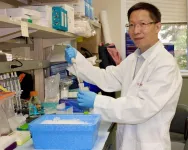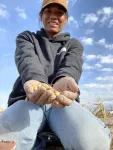(Press-News.org) Researchers from the University of Otago, Christchurch, have spearheaded the discovery of a protein function which has the potential to guide the development of novel cancer treatment options and improve the diagnosis of various cancers.
The exciting research finding, carried out alongside Dr Vanessa Morris from the University of Canterbury’s School of Biological Sciences as well as researchers in Australia and Denmark, centres on the activity of a tumour- suppressing protein called p16.
The discovery, published in the British scientific journal Nature Communications and first authored by University of Otago, Christchurch PhD student Sarah Heath, has shown that p16 has the ability to dramatically alter both its structure and its function.
“This discovery was a real surprise,” says lead researcher Dr Christoph Goebl, a Principal Investigator at Mātai Hāora – the Centre for Redox Biology and Medicine, in the campus’s Department of Pathology and Biomedical Science.
“We know that some proteins can be modified chemically to impact their structure and functions, but this is the first example of such a dramatic structural and functional change”, Dr Goebl says.
“We even found that it’s fully reversible – such dramatic changes were probably not believed possible until now.”
Dr Goebl says under normal conditions, the protein p16 protects cells from uncontrolled cell division. However, once it changes to what’s known as the amyloid (or dysfunctional) state, it loses this protective function.
“We found that the protein does its job perfectly when in the native state but loses all its abilities when in the amyloid state,” he explains.
“We currently think that this transition isn't just a random process but likely a functional switch, and we were very surprised how black and white our results were regarding its function.”
Dr Goebl says his team made the discovery following many years testing p16 in the laboratory, using a combination of molecular and cellular experiments.
He says once the protein is oxidised and in the amyloid state, it can be disassembled and “switched back to normal” by reversing its oxidation. Therefore, the team was able to discover a redox-based amyloid system which can switch between its normal state and the amyloid state by creating or breaking one chemical bond.
“The data looked almost too good to be true, but the more often we repeated our experiments, also with our collaborators overseas, the more confident we were that what we observed was real.”
Dr Goebl says p16 is amongst the top five proteins found to be mutated in various cancers, with the ability to actively cause certain types of cancer when damaged.
“Although this will be a future task for us to fully unravel, it could be that this amyloid transition plays a large role in cancer formation, and potentially also plays a role in the response to certain cancer therapies,” he says.
“This discovery has the potential to guide the development of novel treatment options and improved diagnostic procedures for various cancers.”
The Royal Society Marsden Fund and Health Research Council of New Zealand-backed study took fifteen researchers and four years to reach its conclusions.
With further support from the HRC, alongside fresh funding from the Canterbury Research Medical Foundation and the Cancer Research Trust, the team are now studying this structural transition and how it works in several different types of cancer cells.
“There are multiple avenues we are exploring, some range from using this novel knowledge to improve diagnostic procedures all the way to the development of new treatments that stabilise the protein in its native and healthy state,” Dr Goebl says.
He says this discovery could not have happened without support too from the people of Ōtautahi Christchurch.
“We are very grateful that so many cancer patients here in Christchurch are very generously donating their tissues to the He Taonga Tapu Cancer Society Tissue Bank, which has supported our work so far and will continue to do so in future,” Dr Goebl says.
“I am confident that together with our collaborators in the USA, Canada, Europe and Asia we will be able to understand this new protein behaviour and turn it to our advantage for use in future potential cancer treatments.”
END
New protein discovery may influence future cancer treatment
2024-07-25
ELSE PRESS RELEASES FROM THIS DATE:
Timing matters: Scripps Research study shows ways to improve health alerts
2024-07-25
LA JOLLA, CA—When seemingly healthy people receive an alert from a wearable sensor telling them they might have a respiratory virus—based on small changes in their unique heartrate, sleep and activity patterns—what do they do? According to a new study by Scripps Research scientists carried out at the height of the COVID-19 pandemic, only a quarter of people follow up such an alert with an at-home viral test.
That is just one conclusion of the new study, published in The Lancet Digital Health on July 24, 2024, which tested the feasibility ...
New gene therapy approach shows promise for Duchenne muscular dystrophy
2024-07-25
INDIANAPOLIS - Indiana University School of Medicine researchers have made a significant breakthrough in developing a new gene therapy approach that restores full-length dystrophin protein, which could lead to new treatments for people with Duchenne muscular dystrophy (DMD).
The study, recently published in Nature Communications, demonstrates the effectiveness of their novel gene therapy technology in improving muscle tissue and overall strength in mice models with Duchenne ...
Chemical analyses find hidden elements from renaissance astronomer Tycho Brahe’s alchemy laboratory
2024-07-25
In the Middle Ages, alchemists were notoriously secretive and didn’t share their knowledge with others. Danish Tycho Brahe was no exception. Consequently, we don’t know precisely what he did in the alchemical laboratory located beneath his combined residence and observatory, Uraniborg, on the now Swedish island of Ven.
Only a few of his alchemical recipes have survived, and today, there are very few remnants of his laboratory. Uraniborg was demolished after his death in 1601, and the building materials were scattered for reuse.
However, during an excavation ...
Pacific Northwest launches clean hydrogen energy hub
2024-07-25
RICHLAND, Wash.—The Pacific Northwest is set to begin work building out a clean hydrogen economy with today’s announcement of a Phase 1 funding award from the Department of Energy. The $27.5 million award to the Pacific Northwest Hydrogen Association (PNWH2), a multi-state nonprofit organization, will be matched by industry partners up to $125 million in Phase 1 of the project.
DOE’s Pacific Northwest National Laboratory will serve as an advisor to the PNWH2 by conducting life-cycle analysis to predict and understand the planned hydrogen energy infrastructure impact on decreasing emissions and aiding in community engagement.
Public ...
Tiny deletion in heart muscle protein briefly affects embryonic ventricles but has long-term effects on adult atrial fibrillation
2024-07-25
BIRMINGHAM, Ala. – Millions of adults have atrial fibrillation — an irregular beating of the upper chambers of the heart that yields increased risk of heart failure, stroke and death. Many genetic mutations in the developing fetus can lead to adult atrial fibrillation, including mutations that shorten the massive protein titin in cardiac muscle cells.
Now, in a study in zebrafish and human heart muscle cells, researchers show that a tiny deletion in the A-band of titin — the loss of just nine amino acids out of more than 27,000 to 35,000 amino acids of an intact titin protein — causes a developmental ...
Harms of prescribing NSAIDs to high risk groups estimated to cost NHS £31m over 10 years
2024-07-25
Prescribing non-steroidal anti-inflammatory drugs (NSAIDs) to people at high risk of harm from them is estimated to cost the NHS in England around £31 million and cause more than 6,000 lost years of good health over 10 years, finds a study published by The BMJ today.
NSAIDs continue to be a source of avoidable harm and healthcare costs, and more needs to be done to address this, especially in high risk groups, say the researchers.
NSAIDs are used for pain and inflammation and are one of the most widely prescribed groups of medicines in the world, But they are known to increase the risk of gastrointestinal bleeding, heart attacks, stroke, and kidney damage.
Yet ...
Wearing a face mask in public spaces cuts risk of common respiratory symptoms, suggests Norway study
2024-07-25
Wearing a surgical face mask in public spaces reduces the risk of self-reported respiratory symptoms, finds a trial of adults in Norway published by The BMJ today.
The effect was moderate - a 3.2% reduction in symptoms, equivalent to around 3,300 fewer infections per 100,000 people - but the researchers say these results support the claim that face masks may be an effective measure to reduce the rate of self-reported symptoms consistent with respiratory tract infections.
Observational studies suggest that face masks reduce the risk of respiratory tract infections, but findings from randomised ...
Some private biobanks overinflating the value of umbilical cord blood banking in marketing to expectant parents
2024-07-25
Some private UK biobanks may be misleading expectant parents about the value of storing umbilical cord blood to treat life-threatening diseases that may arise in their child in the future, reveals an investigation by The BMJ, published today.
Over the past decade growing numbers of parents have chosen to store blood from the umbilical cord, which contains stem cells, in case their infant develops a condition that could be treated with stem cell therapy.
Parents must use a private biobank which charges around £550 ...
New research in fatty liver disease aims to help with early intervention
2024-07-25
A new study brings researchers closer to better understanding the pathology of the fatty liver disease MASH, which stands for metabolic dysfunction-associated steatohepatitis.
MASH is a consequence of poor diet and obesity and results in severe damage to the liver. In MASH, the liver becomes filled with active and rapidly multiplying T cells, which are a type of immune cell.
In today’s study, published in Hepatology, researchers examine what these T cells look like and how they work in people with liver cirrhosis (a late stage of liver disease) and in an animal ...
Genetics reveal ancient trade routes and path to domestication of the Four Corners potato
2024-07-25
A new study shows that a native potato species was brought to southern Utah by Indigenous people in the distant past, adding to an ever-growing list of culturally significant plant species that pre-contact cultures domesticated in the Southwestern U.S.
The team of researchers, led by Red Butte Garden and the Natural History Museum of Utah (NHMU) at the University of Utah, used genetic analysis to reveal how and where tubers of the Four Corners potato (Solanum jamesii) had been collected, transported and traded throughout the Colorado Plateau. The findings support the assertion that the tuber is a “lost sister,” joining maize, beans and squash—commonly ...





